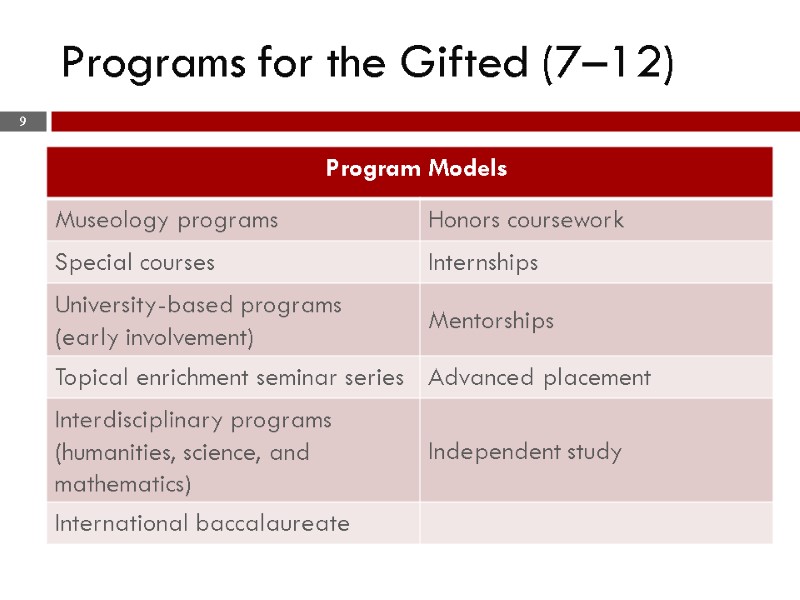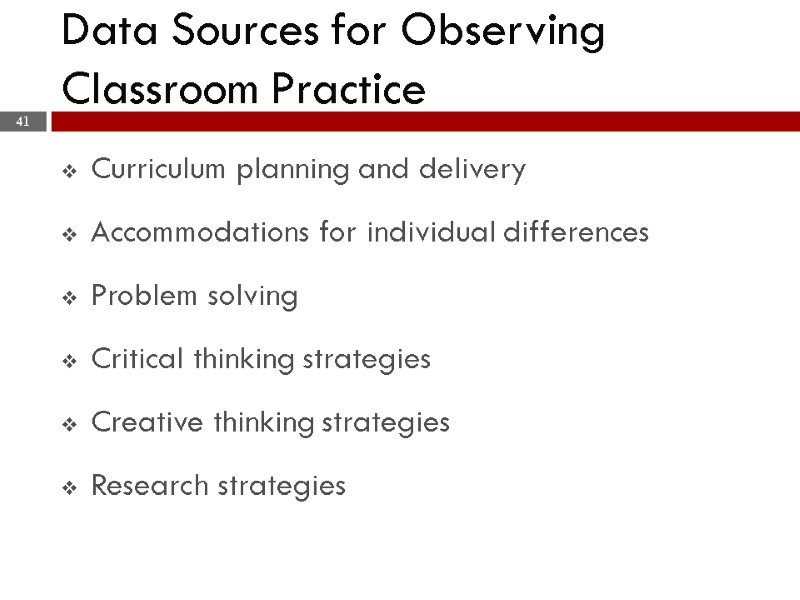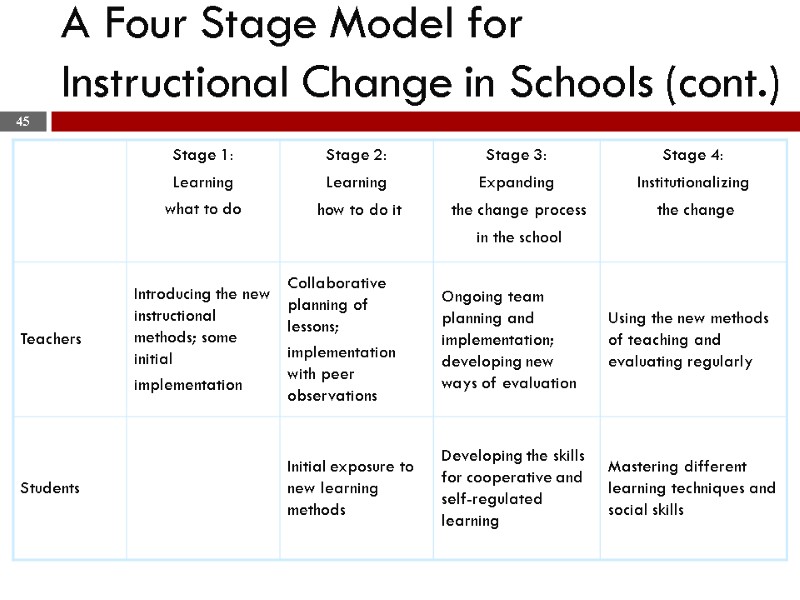Program Planning: Experiences for the Gifted © 2011
















































10610-level_2_theme_1_program_planning_experiences_for_the_gifted.ppt
- Количество слайдов: 47
 Program Planning: Experiences for the Gifted © 2011 by The Johns Hopkins University. All rights reserved.
Program Planning: Experiences for the Gifted © 2011 by The Johns Hopkins University. All rights reserved.
 Participants will be able to : Conduct a needs assessment to determine optimal program direction Analyze multiple options for gifted programming Create options for use in their own schools Session Outcomes 2
Participants will be able to : Conduct a needs assessment to determine optimal program direction Analyze multiple options for gifted programming Create options for use in their own schools Session Outcomes 2
 The 5 A’s of Program/Curriculum Experiences Academically rigorous Affectively integrated Accelerated in core areas and foreign language Advanced in selecting resources Attentive to balance 3
The 5 A’s of Program/Curriculum Experiences Academically rigorous Affectively integrated Accelerated in core areas and foreign language Advanced in selecting resources Attentive to balance 3
 Program Components for Gifted Learners: Pieces of the Puzzle 4 Program Management Program & Service Provisions Identification Personnel Preparation
Program Components for Gifted Learners: Pieces of the Puzzle 4 Program Management Program & Service Provisions Identification Personnel Preparation
 Best Practices in Identification Use of multiple criteria (3 or more) Use of a two-stage process of screening and identification Use of measures that are relevant to program emphasis Equitable processes for selection, validation, and placement 5
Best Practices in Identification Use of multiple criteria (3 or more) Use of a two-stage process of screening and identification Use of measures that are relevant to program emphasis Equitable processes for selection, validation, and placement 5
 Best Practices in Identification (cont.) Placement of students based on individual profile data considerations Consideration of instruments and other approaches sensitive to the inclusion of minority, low socio-economic status, and disabled students Different identification procedures Ongoing identification procedures Identification of students in multiple talent areas 6
Best Practices in Identification (cont.) Placement of students based on individual profile data considerations Consideration of instruments and other approaches sensitive to the inclusion of minority, low socio-economic status, and disabled students Different identification procedures Ongoing identification procedures Identification of students in multiple talent areas 6
 Exemplary Gifted Programs Consensual philosophy and goals that drive the program Accelerative and enrichment opportunities for all gifted learners Articulation of multiple options Specific expectations for student learning Student assessment data systematically collected and used to guide program revision Identification system that uses appropriate approaches 7
Exemplary Gifted Programs Consensual philosophy and goals that drive the program Accelerative and enrichment opportunities for all gifted learners Articulation of multiple options Specific expectations for student learning Student assessment data systematically collected and used to guide program revision Identification system that uses appropriate approaches 7
 Exemplary Gifted Programs (cont.) Plan for staff development Challenging curriculum responsive to student needs and interests Flexibility in scheduling, staff, and student placement Attention to affective needs through guidance opportunities Talent is honored in all domains by the school 8
Exemplary Gifted Programs (cont.) Plan for staff development Challenging curriculum responsive to student needs and interests Flexibility in scheduling, staff, and student placement Attention to affective needs through guidance opportunities Talent is honored in all domains by the school 8
 Programs for the Gifted (7–12) 9
Programs for the Gifted (7–12) 9
 Programs for the Gifted (7-12) 10
Programs for the Gifted (7-12) 10
 What options do you currently have in place/ desire to have in place for gifted learners? Accelerated opportunities Enrichment options Individualized options Counseling Career development Activity 1: Needs and Desired Program Emphases 11
What options do you currently have in place/ desire to have in place for gifted learners? Accelerated opportunities Enrichment options Individualized options Counseling Career development Activity 1: Needs and Desired Program Emphases 11
 Characteristics of Giftedness that Can Impact Early Adolescence Developmentally advanced in one or more areas (uneven development) Learn at a faster pace in selected areas Ask and explore complex abstract questions and issues Experience complex social relationships and issues Desire individual responsibility 12
Characteristics of Giftedness that Can Impact Early Adolescence Developmentally advanced in one or more areas (uneven development) Learn at a faster pace in selected areas Ask and explore complex abstract questions and issues Experience complex social relationships and issues Desire individual responsibility 12
 Sensitivity Hypercritical of self and others (high expectations) Question authority May be introverted May experience learning problems and underachievement for the first time May become bored, withdrawn, isolated, and display low self-concept Characteristics of Giftedness that Can Impact Early Adolescence (cont.) 13
Sensitivity Hypercritical of self and others (high expectations) Question authority May be introverted May experience learning problems and underachievement for the first time May become bored, withdrawn, isolated, and display low self-concept Characteristics of Giftedness that Can Impact Early Adolescence (cont.) 13
 Affective Components of a Gifted School Program Self-assessment Philosophy of life Bibliotherapy (literature and biography) Journal of crystallizing experiences Talent development plan Seminars on gifted issues (e.g. perfectionism, relationships, identity) 14
Affective Components of a Gifted School Program Self-assessment Philosophy of life Bibliotherapy (literature and biography) Journal of crystallizing experiences Talent development plan Seminars on gifted issues (e.g. perfectionism, relationships, identity) 14
 Benefits of Acceleration Improves the motivation, confidence, and scholarship of gifted students over time Prevents the development of habits of mental laziness Allows for earlier access to, and completion of, more advanced opportunities Can reduce the total cost of university education and professional preparation 15
Benefits of Acceleration Improves the motivation, confidence, and scholarship of gifted students over time Prevents the development of habits of mental laziness Allows for earlier access to, and completion of, more advanced opportunities Can reduce the total cost of university education and professional preparation 15
 Accelerated Options for Gifted Students Early entrance Skip the grade at transition points Private tutoring or mentoring Begin studying new subject matter earlier than typical (e.g., foreign language) Fast-paced classes in math, science, and verbal areas 16
Accelerated Options for Gifted Students Early entrance Skip the grade at transition points Private tutoring or mentoring Begin studying new subject matter earlier than typical (e.g., foreign language) Fast-paced classes in math, science, and verbal areas 16
 College courses while in high school College credit via exams Attend college early or without diploma Condense grades 7-8 into one year, condense grades 9-12 into three years Accelerated Options for Gifted Students (cont.) 17
College courses while in high school College credit via exams Attend college early or without diploma Condense grades 7-8 into one year, condense grades 9-12 into three years Accelerated Options for Gifted Students (cont.) 17
 Self-paced instruction in core areas Take AP/IB courses Enter academic competitions Attend summer and Saturday programs that stress advancement Accelerated Options for Gifted Students (cont.) 18
Self-paced instruction in core areas Take AP/IB courses Enter academic competitions Attend summer and Saturday programs that stress advancement Accelerated Options for Gifted Students (cont.) 18
 Philosophy of Gifted Programs Communicates beliefs Provides a platform for achieving consensus Creates a launching pad for policy formulation Promotes program affirmation (commitment to excellence) 19
Philosophy of Gifted Programs Communicates beliefs Provides a platform for achieving consensus Creates a launching pad for policy formulation Promotes program affirmation (commitment to excellence) 19
 Sample Gifted Program Goals To provide mastery of basic content at a pace and depth appropriate to the capacity of able learners To promote critical thinking and reasoning abilities To provide an environment that encourages divergent thinking To develop high-level oral and written skills 20
Sample Gifted Program Goals To provide mastery of basic content at a pace and depth appropriate to the capacity of able learners To promote critical thinking and reasoning abilities To provide an environment that encourages divergent thinking To develop high-level oral and written skills 20
 Sample Gifted Program Goals (cont.) To develop research skills and methods To develop an understanding for systems of knowledge, themes, issues, and problems that frame the external world To develop self-understanding To enhance opportunities for future planning and development 21
Sample Gifted Program Goals (cont.) To develop research skills and methods To develop an understanding for systems of knowledge, themes, issues, and problems that frame the external world To develop self-understanding To enhance opportunities for future planning and development 21
 Sample Gifted Program Goals (cont.) To develop creative and divergent thinking skills To develop problem-solving skills To develop social skills of relating to others and coping effectively in social contexts To develop metacognitive skills that foster independent and self-directed learning 22
Sample Gifted Program Goals (cont.) To develop creative and divergent thinking skills To develop problem-solving skills To develop social skills of relating to others and coping effectively in social contexts To develop metacognitive skills that foster independent and self-directed learning 22
 Activity 2: Establishing Program Goals Select the top five goals for your gifted program based on the examples provided. Be prepared to share the goals with your colleagues. Generate outcomes for each goal. 23
Activity 2: Establishing Program Goals Select the top five goals for your gifted program based on the examples provided. Be prepared to share the goals with your colleagues. Generate outcomes for each goal. 23
 Differentiation Features Acceleration Complexity Depth Challenge Creativity 24
Differentiation Features Acceleration Complexity Depth Challenge Creativity 24
 Differentiation Example: Acceleration 25
Differentiation Example: Acceleration 25
 Differentiation Examples 26
Differentiation Examples 26
 Differentiation Examples 27
Differentiation Examples 27
 Differentiation Examples 28
Differentiation Examples 28
 Differentiation Example: Creativity 29
Differentiation Example: Creativity 29
 Sample Task Demand Ask students to design an experiment to test a question of interest to them: Examples: Do people prefer Product X over Product Y? Are ants attracted to sugar? Are girls more addicted to computers than boys? A research report must be prepared and presented, using technology applications. Be sure to address the hypothesis, data collection techniques, appropriate data tables, conclusions, and implications of the findings based on the original question. 30
Sample Task Demand Ask students to design an experiment to test a question of interest to them: Examples: Do people prefer Product X over Product Y? Are ants attracted to sugar? Are girls more addicted to computers than boys? A research report must be prepared and presented, using technology applications. Be sure to address the hypothesis, data collection techniques, appropriate data tables, conclusions, and implications of the findings based on the original question. 30
 Archetypal Interdisciplinary Task Demand The advance of technology is seen as the basis for many advances in both basic and applied fields of learning. Select the three most important contributions of technology to three different fields. The contributions must be in the last decade. What elements are common to all of the contributions? 31
Archetypal Interdisciplinary Task Demand The advance of technology is seen as the basis for many advances in both basic and applied fields of learning. Select the three most important contributions of technology to three different fields. The contributions must be in the last decade. What elements are common to all of the contributions? 31
 Archetypal Interdisciplinary Task Demand (cont.) Create a scale model of an ideal home for a family of three based on studying the architectural styles of Frank Lloyd Wright, Frank Gehry, and I. M. Pei. Consider these factors in your model: effect of climate, energy conservation, and space limitations. Present your model and defend it to the local architectural review board. What are its major advantages? How will you address its limitations? 32
Archetypal Interdisciplinary Task Demand (cont.) Create a scale model of an ideal home for a family of three based on studying the architectural styles of Frank Lloyd Wright, Frank Gehry, and I. M. Pei. Consider these factors in your model: effect of climate, energy conservation, and space limitations. Present your model and defend it to the local architectural review board. What are its major advantages? How will you address its limitations? 32
 Archetypal Interdisciplinary Task Demand (cont.) One of the major philosophies of the late 19th century in England was Romanticism, occurring in the midst of the Industrial Revolution. Select examples of this philosophy found in art, music, and literature of the time. What aspects of these art forms challenge the assumption that the Industrial Revolution was progressive? 33
Archetypal Interdisciplinary Task Demand (cont.) One of the major philosophies of the late 19th century in England was Romanticism, occurring in the midst of the Industrial Revolution. Select examples of this philosophy found in art, music, and literature of the time. What aspects of these art forms challenge the assumption that the Industrial Revolution was progressive? 33
 Key Components of Learning Assessments Used to promote learning Frequent and on-going Both performance-based and standardized Criteria for judgment are well-defined and used for instruction 34
Key Components of Learning Assessments Used to promote learning Frequent and on-going Both performance-based and standardized Criteria for judgment are well-defined and used for instruction 34
 Appropriate Learning Assessments for Gifted Students Performance-based Portfolio Above-level achievement tests Diagnostic assessments Informal assessments (discussion, observation) 35
Appropriate Learning Assessments for Gifted Students Performance-based Portfolio Above-level achievement tests Diagnostic assessments Informal assessments (discussion, observation) 35
 The Role of Pre-assessment in Teaching and Learning To determine knowledge and skills in an area (functional level) To determine range of differences among learners (differentiation) To determine appropriate interventions for whole and subgroups To revise/refine instructional plans To rethink classroom management strategies 36
The Role of Pre-assessment in Teaching and Learning To determine knowledge and skills in an area (functional level) To determine range of differences among learners (differentiation) To determine appropriate interventions for whole and subgroups To revise/refine instructional plans To rethink classroom management strategies 36
 Evaluating Gifted Programs: Key Beliefs The fundamental role of evaluation is to provide information that can be used to improve and advance the state of the art of gifted programs. Evaluation research is a collaborative process among stakeholders. The use of multiple data sources helps to illuminate the complexity and salience of issues needing to be considered. 37
Evaluating Gifted Programs: Key Beliefs The fundamental role of evaluation is to provide information that can be used to improve and advance the state of the art of gifted programs. Evaluation research is a collaborative process among stakeholders. The use of multiple data sources helps to illuminate the complexity and salience of issues needing to be considered. 37
 Evaluation Questions Question 1: To what extent are the stated mission and goals of the gifted program fulfilled in their actual operation? Question 2: To what extent is the gifted program meeting the needs of identified students as perceived by relevant groups? Question 3: What evidence exists to document positive student performance trends for students participating in the gifted program? 38
Evaluation Questions Question 1: To what extent are the stated mission and goals of the gifted program fulfilled in their actual operation? Question 2: To what extent is the gifted program meeting the needs of identified students as perceived by relevant groups? Question 3: What evidence exists to document positive student performance trends for students participating in the gifted program? 38
 Evaluation Questions (cont.) Question 4: What are the program strengths and weaknesses in relation to the state of the art or best practices in gifted education? Question 5: What are recommendations for program improvement or revision? 39
Evaluation Questions (cont.) Question 4: What are the program strengths and weaknesses in relation to the state of the art or best practices in gifted education? Question 5: What are recommendations for program improvement or revision? 39
 Data Sources Survey of students, parents, teachers, and administrators Focus groups of students, parents, teachers, and administrators Interviews with key administrators Classroom observations Student impact data Review of written documents 40
Data Sources Survey of students, parents, teachers, and administrators Focus groups of students, parents, teachers, and administrators Interviews with key administrators Classroom observations Student impact data Review of written documents 40
 Data Sources for Observing Classroom Practice Curriculum planning and delivery Accommodations for individual differences Problem solving Critical thinking strategies Creative thinking strategies Research strategies 41
Data Sources for Observing Classroom Practice Curriculum planning and delivery Accommodations for individual differences Problem solving Critical thinking strategies Creative thinking strategies Research strategies 41
 Activity 3: Evaluating Gifted Programs Think about each question relative to the gifted program in your school. List the data sources that you could use to respond to these questions. 42
Activity 3: Evaluating Gifted Programs Think about each question relative to the gifted program in your school. List the data sources that you could use to respond to these questions. 42
 Professional Development Change in CLASSROOM PRACTICES Change in STUDENT LEARNING Change in TEACHERS’ ATTITUDES & BELIEFS A Model of Teacher Change Guskey, T. R. (2000). Evaluating professional development. Thousand Oaks, CA: Corwin Press 43
Professional Development Change in CLASSROOM PRACTICES Change in STUDENT LEARNING Change in TEACHERS’ ATTITUDES & BELIEFS A Model of Teacher Change Guskey, T. R. (2000). Evaluating professional development. Thousand Oaks, CA: Corwin Press 43
 A Four Stage Model for Instructional Change in Schools 44
A Four Stage Model for Instructional Change in Schools 44
 A Four Stage Model for Instructional Change in Schools (cont.) 45
A Four Stage Model for Instructional Change in Schools (cont.) 45
 Closing Activity: Change Matrix 46
Closing Activity: Change Matrix 46
 “Change is the law of life. And those who look only to the past or present are certain to miss the future.” John F. Kennedy
“Change is the law of life. And those who look only to the past or present are certain to miss the future.” John F. Kennedy

